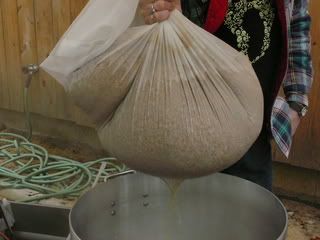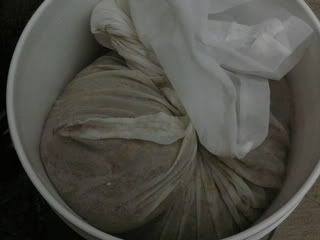1. What volumes you are brewing.
40L end of boil, 10KG grainbill
2. What equipment you are using.
50L pot
3. Whether a rope and pulley is possible for you.
I made it possible
4. Whether you mash out.
I do now that I have a pulley

5. Methods you have tried and why you may have stopped using that method.
I used to brew on a burner on top of a BBQ. This worked well for single batches, but the pot was coming up to shoulder height, making pulling the bag difficult, also I think my bags porosity is quite fine. I found I slopped runnings everywhere getting the hot bag out of the pot and into the bucket... sticky deck = no fun the next day.
When I started doing double batches, I had a very very bad time trying to get the bag out... I ended up on a step-ladder, with my wife holding my hips as I tried to gain some advantage. Not good.
Also, the iron roof above the bbq meant condensation dripping back into the brew... and again, drippings runnings all over the deck... for the next brew I relocated into the carport, installed a skyhook into a beam (took about 2 minutes) and setup a temporary pulley system.
I also lowered the pot to hip height, this makes it much easier to pull the bag, and I could've pulled the 10KG weight bill by hand... but would've dripped everywhere... using the pulley makes it so simple, that I just pulled it up, let it drip for 30 minutes... by which time the bag is cool enough that you can squeeze it by hand... and then move it to a bucket with no drips.
Also, no condensation problems now, but that's another story.
I would like to setup a double pulley for some more mechanical advantage... it was still a bit of a chore raising the bag with just the one pulley... again... its the porosity of the bag.
Next Time
Double Pulley, and make sure the bag is centred over the pot!
Pull the bag up, tie down... let drip while boil starts, squeeze the bejeezus out... let drip... squeeze again... transfer to bucket... sparge, then collect runnings and be done with it.
I have to have the pot up high, so I can gravity siphon into the cubes... but I would say the two biggest factors to difficulty in pulling the bag is pot height and bag porosity, with grainbill size making a small contribution.
The unexpected bonus of using a skyhook is it means I can drip into the pot, which means no drips on the ground, which means no sticky mess to clean up.
So, I just installed a clothes line hook into the beam as high as possible, and a cleat on a nearby wall. The awning pully hooks onto the hook, and the rope has clippy thing which hooks very easily onto the tags my wife embedded into my biab bag.
I love the clippy thing


